April 2, 2020 – Volume 22, Issue 1
In This Issue
- Flanigan’s EcoLogic: Big and Bold Green Steps!
- The Energy Observer Super-Yacht
- Renewable Natural Gas in Philadelphia
- Hybrid Electric Fire Trucks
- Food in the Nude!
- LA’s Hydrogen Energy Storage Solution
- The Urban Drawdown Initiative
- Vermont’s Local Energy Marketplace
- EcoMotion Works to Save the World

Flanigan’s EcoLogic: Big and Bold Green Steps!
Tasmania’s 200% Renewable Target: Tasmania recently announced a 200% renewable energy target by 2040, doubling the island state’s hydro, wind, and solar energy production, with a goal of being Australia’s “renewable energy powerhouse,” looking well past its 100% renewable energy target by 2022.
The island state is located 150 miles south of the Australian mainland, separated by the Bass Strait. It is made up of the main island – the 26th largest island in the world – and 334 surrounding islands. It has a proud history of being a quiet leader on climate action and is building a second interconnector to the mainland to enable export of power from its wind farms.
Thanks to pumped hydro energy storage, Tasmania aims to be the battery of the Australian nation. Its Renewable Hydrogen Action Plan calls for a renewably powered hydrogen generation facility to be up and running by 2024 and to be ready for commercial export hydrogen by 2030. This will create hundreds of local jobs and inject billions into the Tasmanian economy.
New Parks in Chile: Chilean President Michelle Bachelet is establishing a legacy. In 2015, she established two marine sanctuaries covering 350,00 square miles. More recently, she’s established five national parks spanning more than 10 million acres, a swath of territory as big as Switzerland. This was catalyzed by a million-acre gift from a famous “eco-couple,” Doug Tompkins the founder of North Face who died in 2015 and his wife Kristina McDivitt Tompkins, the former CEO of Patagonia. The Tompkins worked to “rewild” much land that had been degraded by industrial practices, but not without controversy. Opposition came from farmers, ranchers, and fish farming. Proponents have successfully advocated the value for tourism and profitable economic development for the long term. The Tompkins also gifted 1.5 million acres of land in neighboring Argentina.
Microsoft’s Leadership:In January, Microsoft, siting the fact that human activity has released more than two trillion metric tonnes of greenhouse gases into the Earth’s atmosphere since the start of the first Industrial Revolution, in the mid 1700s, and the fact that humanity continues to pump more than 50 billion metric tonnes of GHGs into the atmosphere each year, announced a bold plan to be carbon negative by 2030. In an official message, Microsoft noted that,” …those of us that can afford to move faster and go further should do so.” Thus the company announced its plan to reduce and ultimately remove Microsoft’s carbon footprint:
By 2030 Microsoft will the carbon negative, and by 2050 it will remove the environment all the carbon has emitted either directly or by electrical consumption since it was found in 1975, including its supply-chain emissions. Microsoft has established a $1 billion climate innovation fund to accelerate the global development of carbon reduction, capture, and removal technologies. Progress will be published in an annual Environmental Sustainability Report that will detail Microsoft’s carbon impact and reduction journey. The journey includes downstream emissions, empowering customers too, helping them to reduce their footprints thanks to the Microsoft Sustainability Calculator.
8 Billion Trees: In November of 2018, two young men — Michael Powell and Jon Chambers — founded a movement called 8 Billion Trees. Their impetus was to preserve habitat for animals and plants in the world’s most diverse ecosystems. Their organization is focused on saving habitat for orangutans in Indonesia, lemurs in Madagascar, sloths in Brazil, and so many more.
Half of the world’s trees have disappeared in the past 100 years. The Nature Climate Change Society estimates that Earth will lose over half of the planet’s forests by 2050 at the rate we are going, with devastating losses of biodiversity. 8 Million Trees is clear on the multiple benefits of trees for global health. It considers trees the superheroes of the planet. Each second, trees remove 200 tons of CO2 from the environment. 8 Billion Trees’ goal is in its name. The results so far are impressive. It has planted over 1 million trees through its support of full-scale planting operations in 19 countries, it has protected ~25 million trees, and the founders can be proud of saving countless animals.
An acre of trees absorbs six tons of CO2 while reigniting natural water cycles, mitigating the spread of deserts, revitalizing unused areas into fertile farmlands and woods. In developed countries, the average person creates 10 – 20 tons of CO2 each year. Thus it takes 4 – 8 acres of trees to offset each individual’s footprint, some 400 – 4000 trees per person. To my surprise, 8 Billion Trees is headquartered in Las Vegas, Nevada. To donate and be part of its solution, please visit 8billiontrees.com.
Quote of the Week
“This issue is full of big, green steps. It’s about hope and innovation and dedication and has nothingto do with coronavirus.”
The Energy Observer Super-Yacht

The Energy Observer
The Energy Observer is a remarkable super-yacht, the world’s first energy, self-sufficient, zero emissions sea vessel. Its engines are powered completely by renewable energy harnessed from vertical-axis wind turbines and 34 kW of photovoltaic panels. It uses this electricity, backed with lithium-ion batteries, to split seawater to create hydrogen to power a Toyota fuel cell that it then uses to power its engines and onboard services.
The Energy Observer was originally built as a sailboat in 1984, a 30.5-meter catamaran. Then it was completely recrafted to its current configuration and launched in 2017. It’s now on a four-year voyage circum-navigating the globe starting from its home port of Saint-Malo in Brittany, France. The expedition will include three ocean crossings for a trip length of 20,000 nautical miles.
Renewable Natural Gas in Philadelphia
 Consumers in Philadelphia can now elect to purchase Renewable Natural Gas (RNG) to heat their homes and hot water, and to cook their meals. Sold through the Philadelphia Gas Works system, the biogas comes primarily from landfills and is provided by the non-profit Energy Co-op which has served renewable electricity for 20 years. In 2010, the Energy Co-op began providing RNG to Potomac Electric Power Company customers. The RNG does not require any change of appliances, or building new pipes, and will increase monthly gas costs to the average participating home by $15 per month. In California, RNG has been prioritized for fleet vehicles.
Consumers in Philadelphia can now elect to purchase Renewable Natural Gas (RNG) to heat their homes and hot water, and to cook their meals. Sold through the Philadelphia Gas Works system, the biogas comes primarily from landfills and is provided by the non-profit Energy Co-op which has served renewable electricity for 20 years. In 2010, the Energy Co-op began providing RNG to Potomac Electric Power Company customers. The RNG does not require any change of appliances, or building new pipes, and will increase monthly gas costs to the average participating home by $15 per month. In California, RNG has been prioritized for fleet vehicles.
Hybrid Electric Fire Trucks
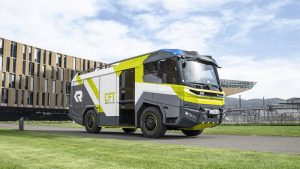
The Rosenbauer Hybrid Electric Fire Truck
One hundred years after the Los Angeles Fire Department retired its horse-drawn first engines, it announced in February that it had purchased its first hybrid electric fire truck… what it considers a $1.2 million investment in the future. The Rosenbauer Concept Fire Truck comes from Austria and will be placed in service in Los Angeles in 2021. It will be the first hybrid electric fire truck in the country and features two batteries with 100 kW of capacity. The fire truck can run for two hours before having to power up its diesel engine.
Food in the Nude!

Food in the nude is a New Zealand campaign to end plastic packaging for fresh produce in supermarkets. Its been driven by the New Zealand Plastic Packaging Declaration which has a goal of making all store and private label packaging 100% reusable, recyclable, or compostable by 2025..A number of New Zealand supermarkets have ditched plastic packaging for produce altogether. One store owner noted that it reminds him of going to market with his dad when he was a kid, when you could smell the fruits and vegetables. This 30-year throw-back appears to be popular with consumers supportive of the “war on plastic” there. Most supermarkets no longer provide single-use plastic bags at check-out either… a phase-out mandated by government regulation.
The Food in the Nude movement has been driven by grocers that noticed an increase in the number of vegetables being supplied in plastic packaging. They thought it was crazy and decided to do something about it. They were inspired by visiting Whole Foods in America where they witnessed a massive range of fresh food and where “merchandising is almost an art form…” without plastic and enabled by misting with reverse osmosis treated water to keep food items fresh and helps to maintain color and texture. The grocers then met with their suppliers in New Zealand, who for the most part were happy to provide produce free of plastic packaging.
LA’s Hydrogen Energy Storage

Mitsubishi Hitachi F-Series Turbine
Los Angeles aims to be the first city in the nation to use renewable hydrogen to store and produce electricity, with the goal of ending the use of carbon-based natural gas entirely. It plans to replace 1,900 MW of coal-fired capacity at the Intermountain Power project plant in Utah with a pair of gas-fired generating units built by Mitsubishi Hitachi Power Systems to produce 840 MW. Then it will link these units to a $1 billion storage project adjacent to the plant where excess renewable power will produce and store hydrogen. The hydrogen will increasingly replace natural gas with hydrogen altogether by 2045… but perhaps sooner. Initially, the converted plant will run on 30% renewable hydrogen.
To produce the hydrogen, excess solar and wind power produced in California will be imported on a 2.4 GW high voltage power line to the plant. The same line will export power to Los Angeles. Replacing coal with natural gas at the plant will reduce its emissions by 65%. With a 30% hydrogen fuel mix, the emissions will be 75% less carbon than coal. By 2045, the plant will have zero carbon emissions.
Swedish Apartment Complex: At a micro scale, a new 172-unit apartment complex in Vargarda, Sweden will run on renewable electricity and heating year-round thanks to a Nilsson Energy RE8760 system. The roof of each of the six buildings there is adorned with 5,400 square feet of photovoltaics. During the long Swedish summer days, the solar powers the complex and charges its battery. Excess is fed to an electrolyzer and compressor for centralized hydrogen production and storage for the winter. During the winter, stored hydrogen is fed to each building’s 5 kW fuel cell for electricity generation while waste heat tops up the heating provided by geothermal heat pumps.
Digging the Green Schools Movement!

Hats off to the tenth Green Schools Conference and Expo, this year in Portland, Oregon held in early March. I attended and was inspired. With my colleagues from 180.org and the Sierra Club, I and was honored to present EcoMotion’s work with creating and financing carbon-free microgrids that can operate indefinitely in the event of macro-grid failure.
Anisa Heming kicked off the Tenth Annual Green Schools Conference. She’s the director of the Center for Green Schools at the U.S. Green Building Council (USGBC). She stated in opening remarks that green schools are pivotal, they support health and wellness and they prepare students to tackle the most important challenges. She talked about the synthesis heart and innovation. Jenny Seydel, Executive Director of the Green Schools National Network (GSNN) is the movement’s self-proclaimed lead rebel rouser. “Disruption is needed in K-12 schools!” There is a profound need to transform the nation’s 14,000 school districts and 133,000 schools. She passed the conference management to the U.S. Green Building Council (USGBC) in 2016.

Mahesh Ramanujam and Ted Flanigan
The President and CEO of the USGBC, Mahesh Ramanujam, welcomed the crowd. “Together we are transforming schools into healthier places, but also empowering young students.” Mahesh stated that by 2019, USGBC had registered 217 million square feet of LEED-certified schools. In the last 12 months, the USGBC certified nine schools at LEED Platinum. “We are known for our plaques but should be known for remarkable people that are products of these schools.”
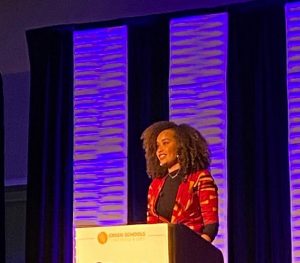
Danni Washington of Big Blue and You
Danni Washington spoke next and ignited the crowd! A self-espoused “Jamaican-American girl from Miami,” inspired by her mom who worked for a cruise line and her love of the ocean, Danni became a marine biologist, founded Big Blue and You with her mom, and became a leading science communicator now with her own Fox TV show. She serves as the bridge between academia and the general public, inspiring the world to reconnect with nature. She told her life story, how her career was catalyzed by YouTube, and how to be an effective storyteller with clear narrative, emotional cues, and relatable content. She talked about social media: Instagram, Pinterest, Twitter, Facebook, Snapchat, LinkedIn, and the newest on the block… Tick Tock. She talked about the importance of 30-second messaging, elevator pitch training, and the simple actions that she puts forth that people can easily grasp to take action and get that great feeling of making a positive contribution to the planet.
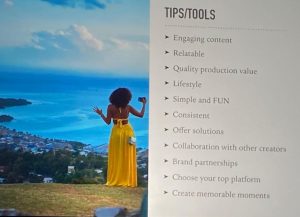
Two stories from the conference struck me: The first was told by Superintendent Tony Knight of the Oak Park Unified School District in Ventura, California. It’s a K-12 public school district with 4,500 students, among the first of California’s Green Ribbon Schools. I was struck by how the district used recycled shipping containers to build classrooms, which feature indoor-outdoor learning spaces. The district promotes “deep, nature-based learning” with campuses complete with cool rooves, solar energy, battery energy storage, electric vehicle charging, bioswales, organic landscaping, the use of green cleaning and much more. Its food cafeteria program is “plant forward” with only poultry options. Every tree on campus is registered and cared for. Students learn ocean literacy and make a connection with the nearby Channel Islands.
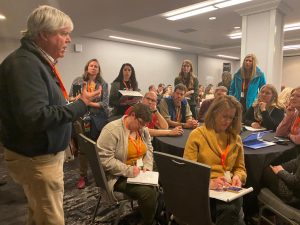
Dr. Tony Knight, Oak Park Unified School District
The Hood River (Oregon) Middle School is lucky to have teacher Michael Becker on its staff. He catalyzed FACS there… Food and Conservation Science. His message was new to me: “You gotta have a kitchen on campus.” Some years ago he went to his school board with notion of “Green STEM (Science, Technology, Engineering, and Math).” They bought it. He hosted a eco-charrette to expand the school and to incorporate a large greenhouse into its design as a living system to grow food and fish, to heat the school thanks to its 14,000 pound seasonal rock battery, and to educate its students. It now produces fresh tomatoes through December. The design also includes solar power, a radiant geothermal heating system, a giant rainwater tank.
Today the school grows much of its food and even sells it in the community. After three years of harvesting food, cooking and serving it, eighth grade students are certified as State of Oregon Food Handlers which prepares them for jobs. Students at the conference talked about their experiences; their excitement about making food for the school board. At one event the students served pizza to 150 people. The commercial kitchen is known as the Conflict Café… teaching students about geography and world conflicts as they study, grow, and cook food from all over the world. FACS does all recycling for entire building. In summer, students’ families take on gardens with summer sales at farmers market allowing kids to earn money in the process.
Thanks to the teachers, administrators, facility directors, suppliers, and specialists of all kinds that are driving the green schools movement. And thanks to the USGBC for convening an inspiring and motivational event.
Healthy Foods in Schools: In related news, two schools in Marin County, California now serve their students 100% organic meals, sustainably sourced and free of genetically modified organisms. Students there now eat fresh, local food year-round thanks to a partnership with the Conscious Kitchen, a project of the environmental education non-profit Turning Green. Its founder noted that the program is not only meetings U.S. Department of Agriculture (USDA) nutritional standards, but “ties the health of our children to the health of our planet.”
The meals in Sausalito are being accompanied by nutritious and gardening education. Tested first in 2013 with 156 students, the program resulted in decreased disciplinary cases and increased attendance. The Conscious Kitchen project consultant notes that, “successfully disrupts the cycle of unhealthy, pre-packaged, heat and serve meals that dominate school kitchens.”

Nutritional experts have long pointed out that food and beverages in schools have a long-term impact on children’s health and well-being. The 2010 Healthy and Hunger Free Kids Act required schools in the United States to update their meal provisions to meet new USDA nutritional standards and to offer more whole-wheat products, fresh fruits and vegetables, and lean proteins for students that receive subsidized school lunches. Berkeley’s Edible Schoolyard Project has long advocated that it is equally important to focus on student education through hands-on lessons taught in classroom, kitchen, and garden. Coupled with education, healthy means are much more likely to be sustained throughout students’ lives.
Franklin Elementary Micro-Recycling: Several weeks ago EcoMotion visited the Franklin Elementary School in Glendale, California where a group of concerned parents – led by my friend Monica Campagna – spearheaded an exemplary effort to address lunch waste. They wanted to eliminate the single-use food trays coming out of the cafeteria, and to sort wastes for composting and recycling. The team sought a donation for a commercial washing machine… and got one. Now stiff plastic trays are reused again and again. We witnessed young student volunteers standing guard making sure that all lunch “waste” is properly recycled, students using oversized tongs on long strings to pull misplaced materials from garbage cans. I call this micro-recycling. I was struck by the simplicity and elegance of share boxes for fruits and unopened yogurt, so that kids that have extra enable kids that are still hungry to eat more. Compost is then distributed to classrooms, each of which have worm bins… every kid learning about vermiculture. We congratulate Monica and her colleagues. Their work is exemplary.
The Urban Drawdown Initiative
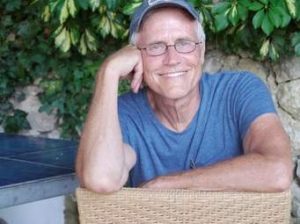
Paul Hawken
The Urban Drawdown Initiative was inspired by Paul Hawken’s book Drawdown. In 2017 a group of cities began exploring the role of cities in carbon drawdown. Working with the Urban Sustainability Director’s Network and the Carbon Neutral Cities Alliance, cities began developing innovative solutions to drawdown carbon emissions… creating a framework and set of action pathways supported by a resource database.
One of the pathways by which cities and counties are drawing down carbon is by putting it back in the soil. Cities own land: Boulder County, Colorado has more than 75,000 acres of open space. San Francisco owns rangeland in its watershed, plus power and water rights-of-way that are suitable for treatment with compost to achieve additional sequestration. It has collected over 2 million tons of organics and produced over 700,000 tons of carbon-absorbing compost. Cities like Stockholm, Helsinki, and Amsterdam are linking local biomass resources to community-based bioenergy and biochar systems that accelerate sequestration.
This are exciting developments… new means for society to cut emissions and reach the Paris Accord’s goals. Craig Ebert of Climate Action Reserve notes over a Whole Foods lunch that a new class of soil-based carbon solutions – what he calls natural working land solutions — provide great promise of major contributions in achieving global greenhouse gas reduction targets.
EcoMotion Works to Save the World
Proud of real projects… projects that are making a difference saving the world. At EcoMotion, our work is ever more important and ever-more valuable to our global society. We’re proud to have worked for the City of Santa Monica for 13 years, and 7 years for LA Metro. We work hard for our clients to achieve their sustainability solutions. A few highlights of our team’s current works:
Capital Group Companies: When Southern California Edison’s rules changed regarding maximum solar per site, EcoMotion was on hand again to help the Capital Group Companies to dramatically expand its solar system at its Irvine, California campus. At the time of Phase 1 Solar, its 1 MW was the largest corporate solar system in Orange County. Now EcoMotion is helping add 1.6 MW to the system with photovoltaics covering six major office buildings and the fourth parking structure.
Chula Vista Works: EcoMotion is knee-deep in Chula Vista, California, working on a 48-campus solar project that will save the district well over $50 million while providing 100% clean energy to each site. And we’re knee-deep in Ebus deployment. EcoMotion is advising the district there on Ebus selection, charging infrastructure, and smart energy management platforms that minimize demand charges and which prepare the district for vehicle-to-grid technologies. Imagine schools of the future that use solar to power their bus fleets, and then have the added benefit of being able to deploy a fully charged Ebus with ~150 kWh on board to a school site experiencing a grid outage.
BIM – Model R: Some years ago, EcoMotion developed the Benefactor Investment Model with stable member Mark Hopkinson. For schools and non-profits, why not tap the financial resources of benefactors to finance systems, monetize tax credits and depreciation benefits, earn small returns, and recoup their money entirely while providing a school with a solar system in year six that will provide free power for the next 19 years… at least! This very friendly PPA model now has a new wrinkle: Model R. EcoMotion is now working for a benefactor keen on solarizing schools… as many as possible and soon! Model R – for Revolving – provides discounted power to schools for 25 years, allowing the benefactor to revolve the value to additional schools. So far we have one school district under contract, in final design and permitting, preparing for construction this summer.
Other highlights include EcoMotion’s recent white paper on “Unpacking Energy Resilience” that compares and contrasts generator, fuel cell, microturbine, and solar+ storage solutions. Visit www.EcoMotion.us to download it. We’re managing a 20,000+ LED fixture retrofit at the Murrieta Valley Unified School District. Thanks to our current experience establishing the City of Glendale’s Sustainability Office, we’re developing a tool kit for cities interested in establishing strong sustainability programs, with lessons on how to structure sustainability and to effectively involve the community. In Panorama City, California, our team is involved in a High-Performance Rooftop Project that combines re-roofing with reflective surfaces and bifacial solar panels.
